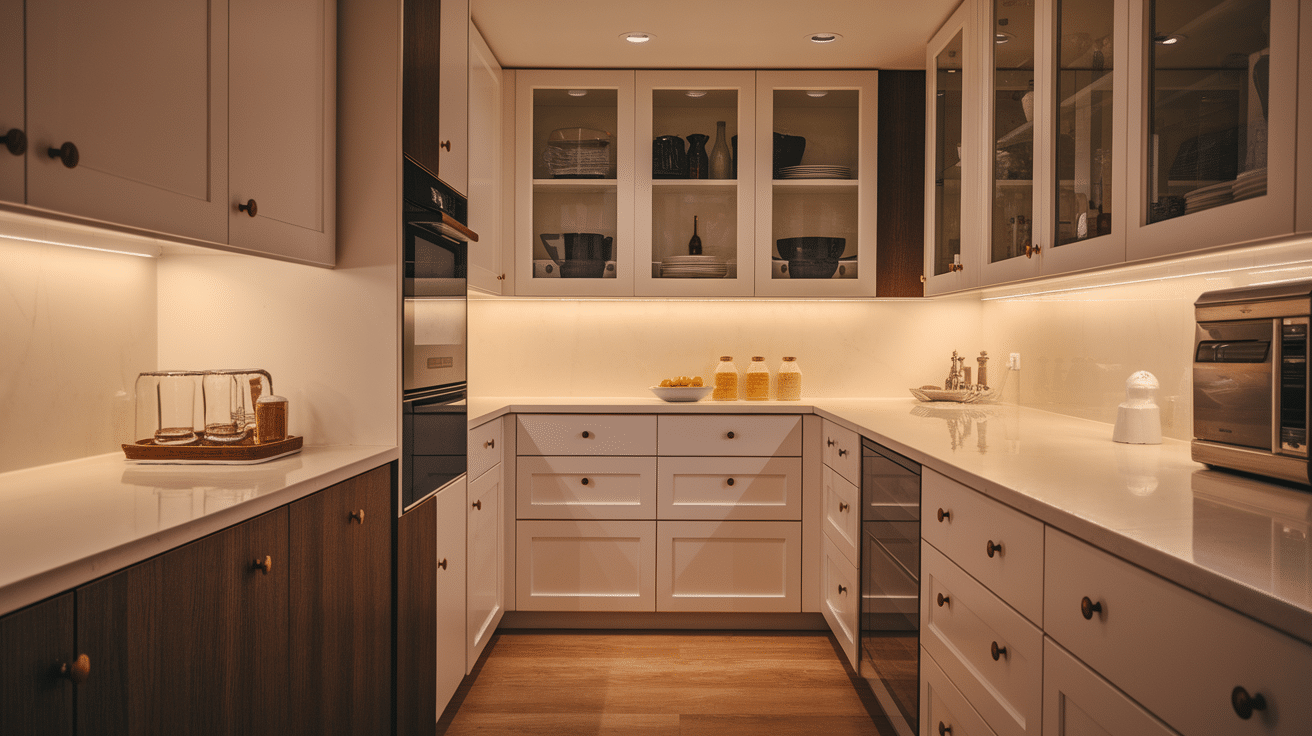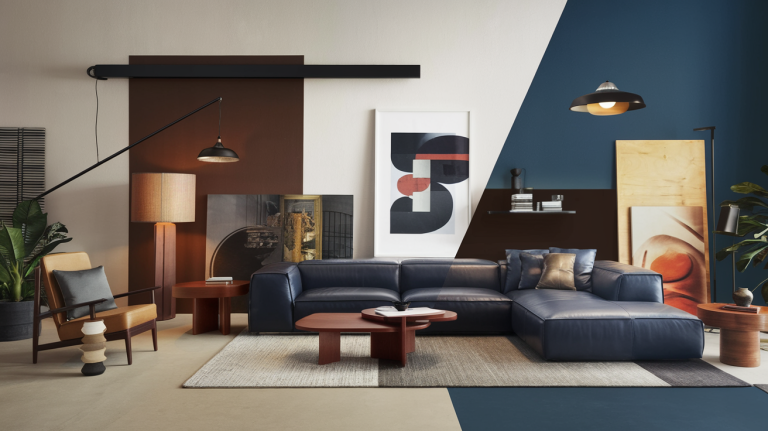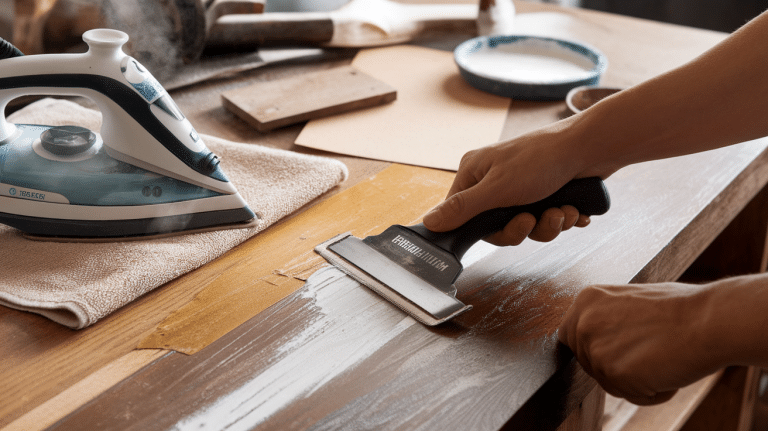Kitchen Cabinet Knob Placement Made Simple
Getting your kitchen cabinet knob placement wrong can turn your dream kitchen into a daily frustration. You reach for the cabinet doors only to find awkward grips, uneven spacing, and hardware that looks off.
The good news is that perfect kitchen cabinet knob placement follows proven rules that any homeowner can master.
When you understand the right measurements and professional techniques, you can create a kitchen that looks polished and functions flawlessly.
This article covers everything you need for expert kitchen cabinet knob placement.
You’ll learn standard measurements for different cabinet types, how to handle corner situations, when to choose knobs versus pulls, and installation tips that prevent common mistakes.
By the end, you’ll have the confidence to install cabinet hardware like a pro.
Standard Knob Placement Guideline
Proper kitchen cabinet knob placement follows specific measurements that create both function and visual appeal. These guidelines work for most standard cabinet configurations.
In most cases, a 2.5 to 3-inch distance from the edge of the cabinet or drawer is ideal.
This general guideline applies across upper cabinets, lower cabinets, small drawers, and large drawers, though adjustments can be made for specific styles or personal preferences.
This spacing rule exists for both practical and visual reasons. The 2.5 to 3-inch distance prevents knobs from being too close to weak edge areas where wood might split or crack.
It also ensures knobs are positioned in the strongest part of the door frame. Visually, this spacing creates balanced proportions that look intentional rather than awkward or cramped.
| Cabinet Type | Knob Position | Height Consistency |
|---|---|---|
| Upper Cabinets | Bottom rail | Same across all uppers |
| Lower Cabinets | Top rail | Same across all lowers |
| Small Drawers | Center position | Align with cabinet knobs |
| Large Drawers | Center or double | Match the cabinet alignment |
Knob size affects these measurements. Large knobs (over 2 inches) need more space from edges, while small knobs (under 1 inch) can be placed closer but need precise centering.
Standard knobs (1-2 inches) follow the traditional spacing rules and work well with most cabinet sizes.
1. Upper Cabinets
For upper cabinets, place knobs on the bottom rail of the door frame. This positioning feels natural when you reach up to open doors.
Keep knobs at the same height across all upper cabinets. This placement positions the knob at a comfortable reach height and creates a clean, horizontal line when viewed from across the room.
2. Lower Cabinets
Lower cabinet knobs go on the top rail of the door frame. This makes them easy to grab without bending down too far. Use the standard measurements for consistent spacing across all lower cabinets.
Some people prefer placing lower knobs slightly closer to the corner (around 2 inches), which can work well if you have smaller doors or choose a more compact look.
3. Small Drawers (Under 12 Inches Wide)
For small drawers, place knobs in the center position of the drawer front. This positioning creates balance and feels natural when pulling the drawer open.
Keep knobs aligned with adjacent cabinet knobs when possible. This placement ensures the knob is easy to grip and doesn’t interfere with the drawer’s operation while maintaining visual consistency with your cabinet hardware.
4. Large Drawers (Over 12 Inches Wide)
Large drawer knobs can be placed in the center, or use double knobs for better balance. This positioning makes wide drawers easier to open and gives them a more proportional look.
For double knobs, space them 3 to 4 inches from each end and center vertically on the drawer front. Match the height alignment with your overall kitchen cabinet knob placement.
Double knobs work better for drawers over 18 inches wide, while single center knobs are fine for drawers between 12 and 18 inches, but may look small on extensive drawers.
Where to Put a Knob on Different Kitchen Cabinets?
Different cabinet styles need slightly different approaches to kitchen cabinet knob placement. The door construction affects where knobs look and work best.
1. Shaker-Style Cabinets
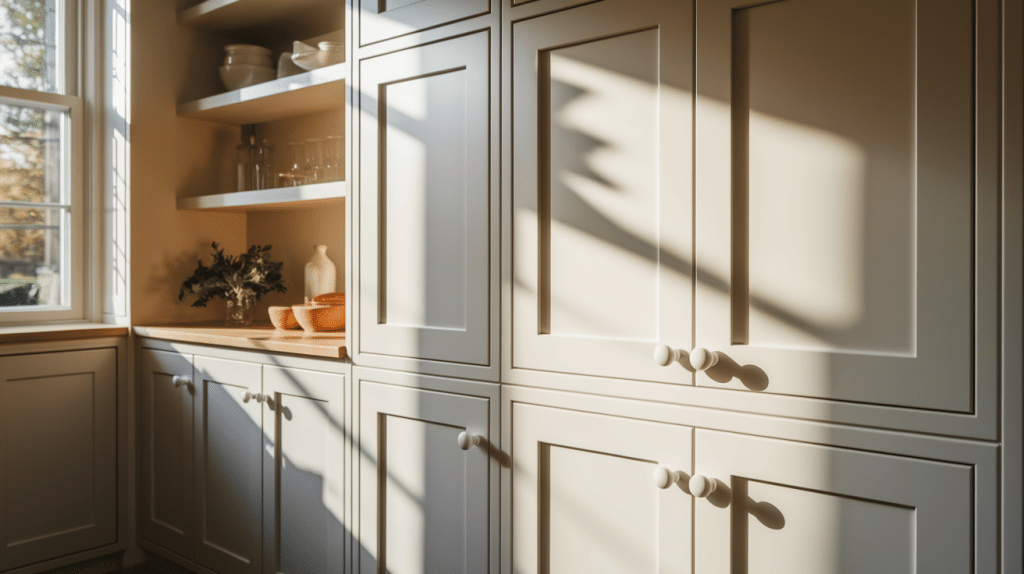
Shaker cabinets have a flat center panel with a raised frame. This style gives you clear guidelines for knob placement.
Best placement:
- Position knobs on the frame, not the center panel
- Use the corner where the vertical and horizontal frame pieces meet
- This creates a balanced, traditional look
The raised frame provides a natural guide for consistent placement. The frame corners are the strongest part of the door, making them ideal for hardware.
2. Slab-Style Cabinets
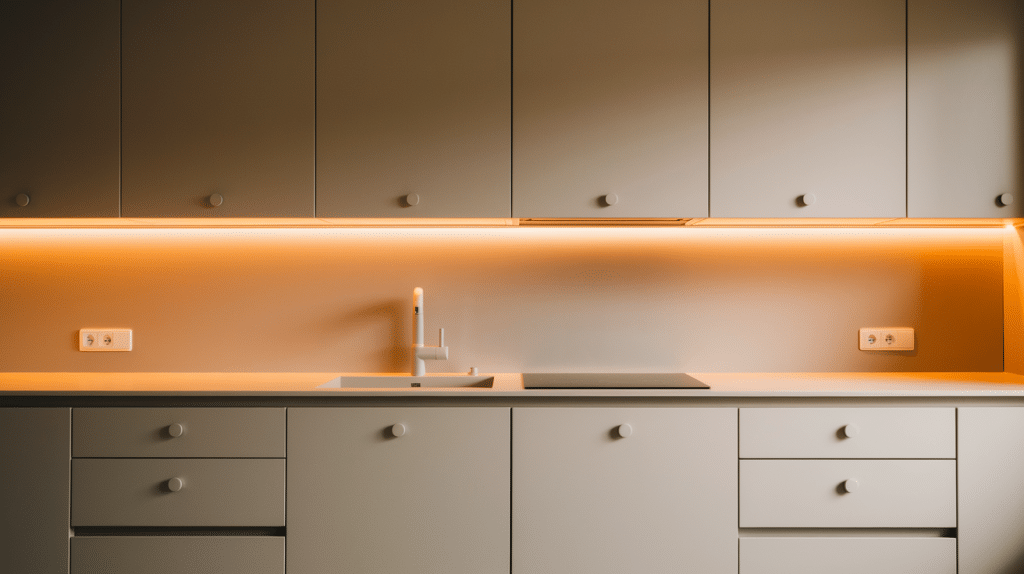
Slab doors are flat with no frame or panel details. This gives you more flexibility but requires careful planning.
Best placement:
- Create visual interest by being consistent with spacing
- Consider the overall kitchen layout when choosing a position
- Upper and lower knobs should align vertically when possible
Without frame details to guide you, consistency becomes even more important. Use templates and measure carefully.
3. Glass-Front Cabinets
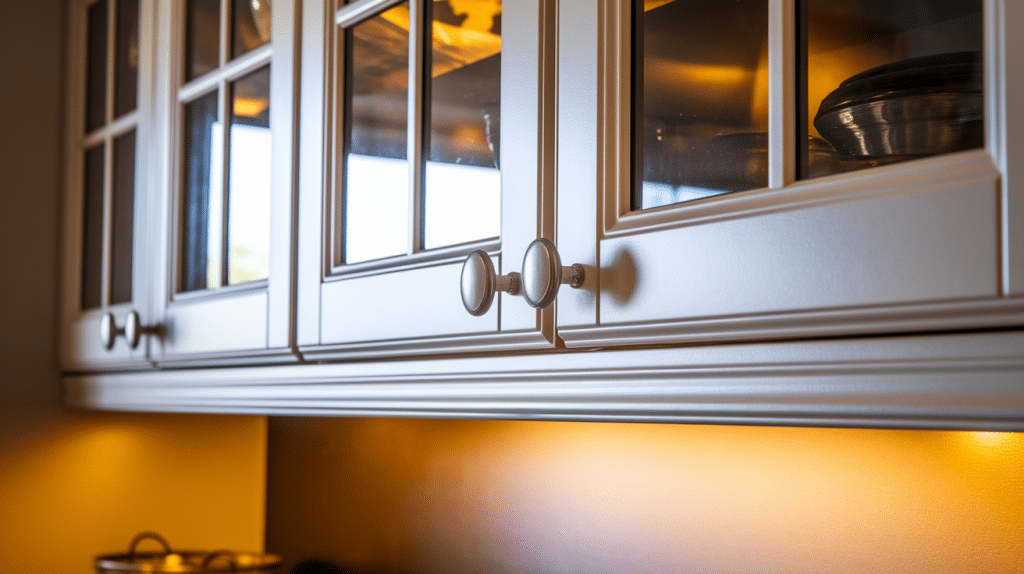
Glass-front cabinets need special consideration for kitchen cabinet knob placement. The glass affects both function and appearance.
Best placement:
- Place knobs on the solid frame, never on the glass
- Choose the side opposite the hinges for easy opening
- Keep knobs low enough to avoid the glass area
- Consider how the knob looks through the glass
4. Corner Cabinets
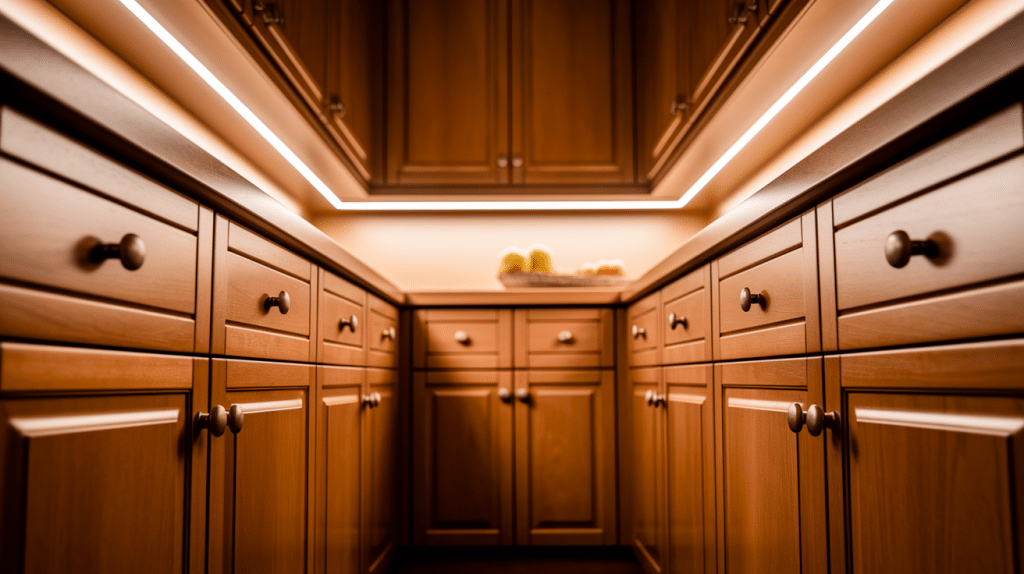
Corner cabinets present unique challenges for kitchen cabinet knob placement. These specialized cabinets need special attention to work well and look right.
Best placement:
- Place knobs on the angled edge that’s easiest to reach for diagonal doors
- Use knobs on both doors for double-door Lazy Susan setups
- Position knobs on the room-facing door for blind corner cabinets
- Keep knobs clear of rotating mechanisms and pull-out shelves
- Test the door swing and rotation before final placement
Now that we’ve covered the fundamentals of knob placement, it’s important to consider one key decision that will impact both functionality and design: whether to use knobs or pulls for your cabinets.
Knobs vs. Pulls: Which to Choose for Your Cabinets
Choosing between knobs and pulls affects your kitchen cabinet knob placement strategy. Each has different placement rules and visual effects.
| Feature | Knobs | Pulls |
|---|---|---|
| Best for Door Size | Smaller doors (under 18 inches) | Larger doors and drawers |
| Kitchen Style | Traditional or farmhouse styles | Modern or contemporary styles |
| Drawer Usage | Light-use drawers | Heavy drawers need a strong grip |
| Budget | More budget-friendly option | Higher cost investment |
| Placement | Single point, corner positioning | Can be centered or horizontal |
| Grip Style | Pinch grip with fingers | Full-hand grip for leverage |
Knobs follow the standard positioning rule and create single focal points on each door.
Pulls require different considerations since they can be placed horizontally across the center of doors or vertically along the edge. Pull placement depends on door proportions, with longer pulls needing more clearance from edges and corners.
The size difference also impacts spacing. Knobs take up minimal visual space and work well with the standard measurements.
Pulls create linear elements that can make doors appear wider or taller depending on orientation, requiring careful alignment with adjacent cabinets to maintain visual balance throughout your kitchen.
Professional Cabinet Knob Installation Tips
To ensure a flawless and professional finish, here are some expert tips for installing your cabinet knobs with precision and ease.
- Use the exact measurements throughout your kitchen. If you choose 2.5 inches from the edge, stick with it for every cabinet.
- Create a template from cardboard or wood. Mark your measurements and use them for every door. This prevents measurement errors.
- Double-check before drilling. Place all knobs with painter’s tape first. Step back and look at the overall pattern before making holes.
- Consider the door swing direction. All doors should have knobs on the same side relative to their hinges.
- Center drawer knobs carefully. Measure the drawer width and height, then divide by 2 to find the center point. Mark where these measurements meet and adjust for visual balance if needed. Sometimes, the mathematical center doesn’t look right, so trust your eyes.
4 Common Cabinet Knob Placement Mistakes
- Misaligned knobs: Knobs that don’t line up create a messy, unprofessional look. Use a template for consistent measurements, mark all knob positions before drilling any holes, and check alignment with a level or straight edge. Take photos from different angles to spot problems.
- Placing knobs too close to edges: Knobs placed too close to door edges can split the wood or look cramped. Consider the knob size when measuring, and test grip comfort before final placement.
- Mixing styles inconsistently: Random mixing of knob styles, sizes, or placements confuses the eye. Choose one knob style for the entire kitchen, use the same finish throughout, and follow consistent placement rules. If mixing hardware, have a clear plan.
- Not considering door thickness: Thick doors need longer screws and different knob considerations. Measure door thickness before buying hardware, choose appropriate screw lengths, and consider how thickness affects knob projection. Test fit before final installation.
Final Thoughts
Have you ever noticed how professional kitchens always seem to have perfectly placed hardware that looks effortless yet intentional?
That’s because they follow the same kitchen cabinet knob placement principles you now understand. Getting your kitchen cabinet knob placement right isn’t just about following measurements; it’s about creating a kitchen that feels natural to use and looks professionally designed.
The 2.5 to 3-inch spacing rules and design principles in this article will help you avoid common mistakes that make kitchens look amateur.
Remember to test your placement with painter’s tape before drilling, stay consistent with your measurements, and consider how different cabinet styles affect your approach.
With these kitchen cabinet knob placement strategies, you’re ready to change your kitchen into a space that’s both beautiful and functional.

